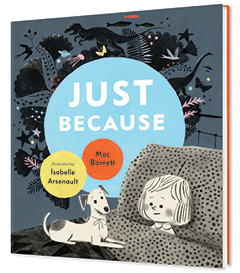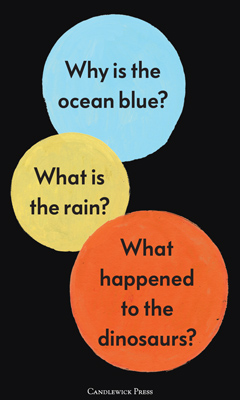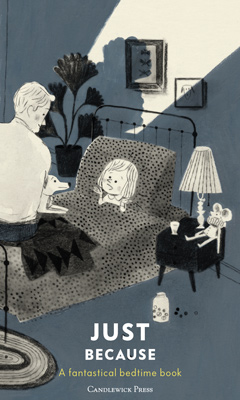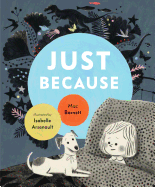Just Because
by Mac Barnett, illus. by Isabelle Arsenault
"Why is the ocean blue?"
"Every night, when you go to sleep, the fish take out guitars. They sing sad songs and cry blue tears."
"What is the rain?"
"The tears of flying fish."
So begins Mac Barnett and Isabelle Arsenault's tender picture book collaboration, Just Because. A series of questions and beautifully outlandish answers, the soft call-and-response style of the book soothes and entertains as each rejoinder is more inventive than the last.
A young girl is tucked snugly into bed in an evening-dark room, a small dog wearing a cute little bow is sprawled on her comforter. Both girl and dog are awake and alert despite the late hour. The door to the bedroom is open and her father peeks in, the hallway light spilling around him. On the left-hand page, in a blue circle on a black background, we see the question: "Why is the ocean blue?" The page turn reveals a double-page spread in shades of gray, blue the only accenting color. Two fish--one sporting sunglasses, the other wearing a cap--strum guitars, their mouths wide open, tears spilling.
The little girl turns to her dad, who has moved a little further into the room, making the shadow-shapes on the wall shift and change. "What is the rain?" Dad's arms are crossed and shoulders hunched as he comes up with his next answer. The page turn reveals a grayscale illustration of flying fish moving in a school above a quaint city. One fish has a hat tied to his head with a tiny bow around his gills; another wears a beret; all are crying.
Next is a fiery red circle on the question page: "Why do the leaves change color?" Dad sags against the door jamb, a far-off look on his face. "In autumn, when the world gets colder, the trees keep warm by setting quiet little fires in their leaves. By winter, their branches have all burned up." On the page turn, the bright, bold red of the background is a stark contrast to the dark birds and branches in the foreground. Birds warm themselves around a tiny little fire made of one single, solitary leaf. Dark smoke rises above them and spills off the page as dozens of little spark-of-light leaves burn around the birds. (More hats here, too--three of the birds are wearing winter beanies, one with a handsome pompom on top.)
Now it's the girl's turn to have a far-off look. Dad, however, is entirely in the bedroom now, standing next to the bed, hands on hips, a pleased look on his face--he's found his rhythm. The dog looks at Dad while the girl looks into the distance: "Why do birds fly south for the winter?" It's obvious, isn't it? "To fetch new leaves for the trees." The double-page spread features a lush, vibrant green that matches the question-circle from the page before. A tangle of plants fills the left-hand page, spilling over the gutter onto the right. Two birds fly off, new leaves clutched in their beaks, hats fitted snugly atop their heads or tied under their chins in happy little bows. A tiny insect waves goodbye from the tangle.
The little girl is exploding with inquiries, and brightly colored question-circles fill an entire double-page spread: "What is a volcano"; "Why do we sneeze?"; "How does an egg become a chicken?" Of course, this game can't continue all night, and Dad finds a way to bring the questions to an end. As Dad leaves, readers get their first glimpse at the other side of the girl's room, where a guitar, a fish and several bird figures (among other things) can be seen.
Just Because is a meticulously planned, "carefully structured" picture book, with deliberate thought behind both text and illustration. "It's a catechism," Barnett says, "The questions and answers are arranged in couplets: the father's first answer unfurls a wild and sprawling premise; his second answer snaps things shut in iambic trimeter. (The final couplet reverses this rhythm.)" This arrangement, he hopes, "creates a pleasant cadence and provides narrative energy." The back-and-forth between child and father is both calming and wholly enjoyable, creating a book that could easily be read aloud to a single child or a large group.
Arsenault's gouache, pencil, watercolor and digital illustrations enhance Barnett's text, the color palette fitting within the same strict parameters as his words. Each double-page spread features the color from the page before, until there are no more questions to ask and all of the colors appear together. Like the text, every illustration is magnificently imaginative, the boundaries of the ideas moving far beyond the confines of the picture book's structure. Arsenault's illustrations also give the book continuity, tying all of the couplets together with recurring visuals that connect the real world with the imagined. Sweet and friendly, sassy and silly, Just Because is likely to strike a chord with parents and will almost certainly be adored by children. Why? Just because.









